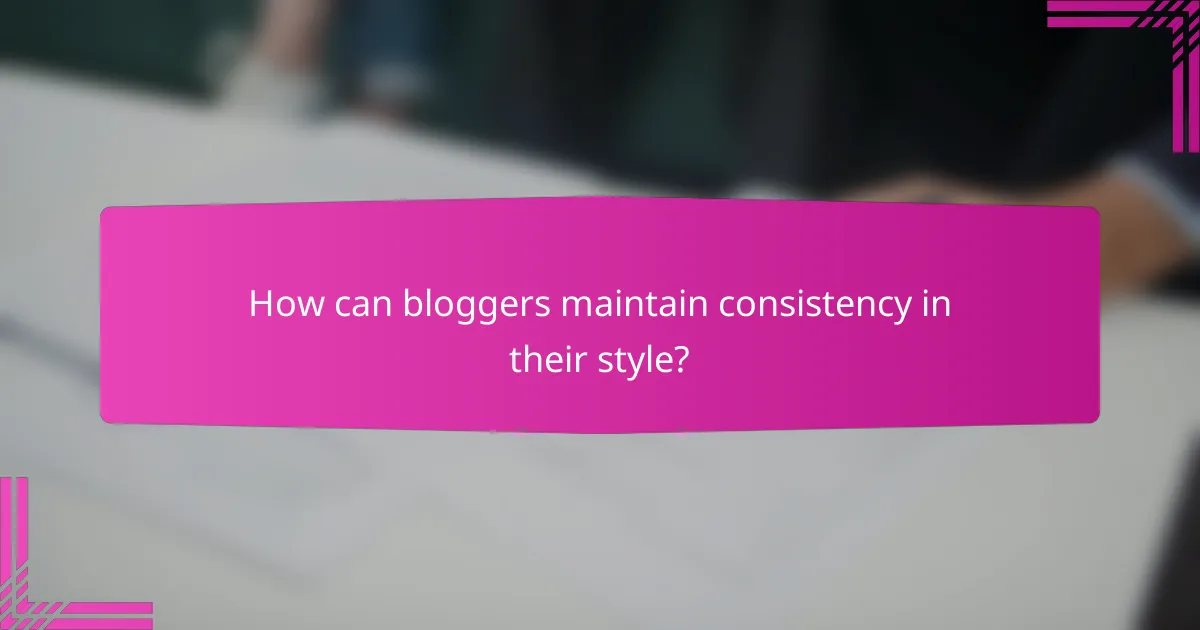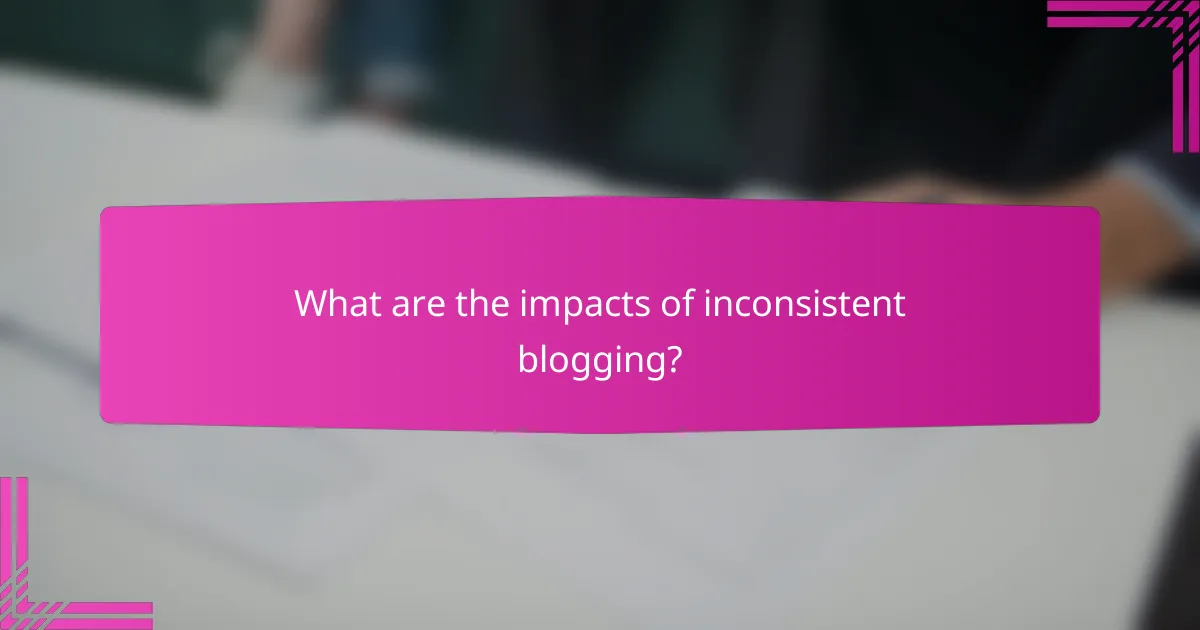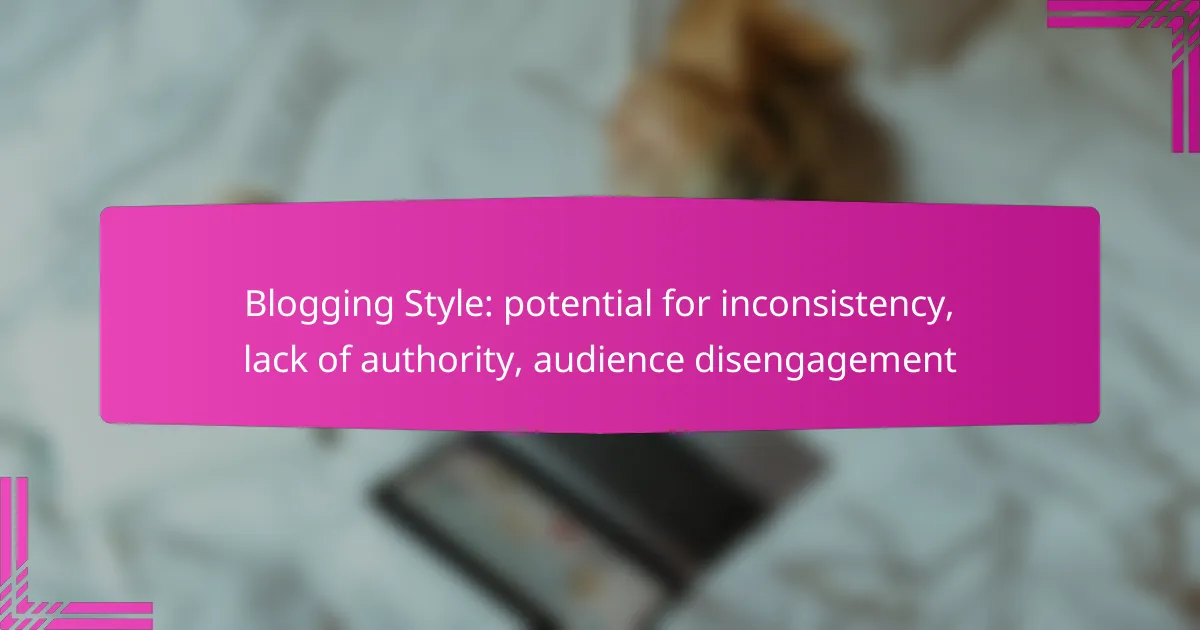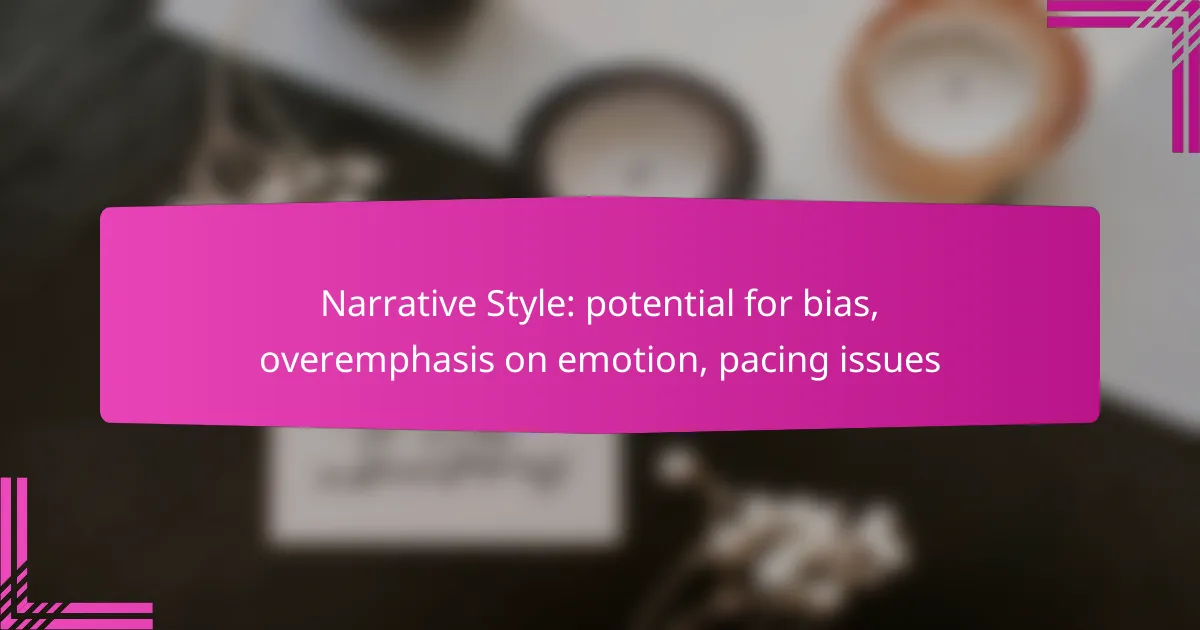Inconsistent blogging can lead to a decline in audience engagement and trust, ultimately undermining the blog’s effectiveness. By failing to maintain a uniform voice and quality, bloggers risk losing their authority and prompting readers to seek more reliable sources. Establishing clear guidelines and regularly reviewing content can help mitigate these issues, fostering a more engaged and loyal audience.

How can bloggers maintain consistency in their style?
Bloggers can maintain consistency in their style by establishing clear guidelines and regularly reviewing their content. This ensures that their voice, tone, and formatting remain uniform, which helps build authority and keeps the audience engaged.
Establish a style guide
A style guide is a crucial tool for bloggers to define their voice, tone, and formatting preferences. It should include rules on grammar, punctuation, and stylistic choices, such as the use of headings, bullet points, and images. For example, specifying whether to use American or British English can prevent inconsistencies in language.
Additionally, a style guide can outline how to handle specific topics or sensitive issues, ensuring that the content remains respectful and appropriate for the target audience.
Use editorial calendars
Editorial calendars help bloggers plan and organize their content in advance, promoting consistency in posting frequency and topics. By scheduling posts, bloggers can ensure a balanced mix of content types, such as tutorials, opinion pieces, or product reviews. This planning helps maintain a steady flow of content that aligns with the audience’s interests.
Using tools like Google Calendar or dedicated editorial calendar software can facilitate this process, allowing for easy adjustments and collaboration with team members.
Regularly review content
Regular content reviews are essential for maintaining consistency in a blog’s style. This involves revisiting older posts to ensure they align with current guidelines and updating them as necessary. For instance, if a blogger has changed their tone or formatting, older posts may need revisions to match the new style.
Setting a schedule for content reviews, such as quarterly or biannually, can help keep the blog fresh and relevant, while also reinforcing the established style.
Implement feedback loops
Creating feedback loops allows bloggers to gather insights from their audience and peers, which can inform style consistency. Encouraging comments, conducting surveys, or engaging on social media can provide valuable input on what resonates with readers. This feedback can highlight areas where the style may need adjustment or reinforcement.
Regularly reviewing this feedback ensures that the blog evolves while still adhering to its core style principles, fostering a stronger connection with the audience.
Utilize writing tools
Writing tools can significantly enhance consistency in a blog’s style by providing real-time suggestions for grammar, tone, and readability. Tools like Grammarly or Hemingway Editor help identify inconsistencies and suggest improvements, making it easier for bloggers to adhere to their style guide.
Additionally, using templates for different types of posts can streamline the writing process and ensure that formatting remains consistent across the blog. This approach saves time and reinforces the established style with each new post.

What are the impacts of inconsistent blogging?
Inconsistent blogging can significantly undermine a blog’s effectiveness by eroding trust, reducing engagement, and diminishing perceived authority. When content quality and frequency vary, audiences may disengage and seek more reliable sources.
Reduced audience trust
Inconsistency in blogging can lead to a decline in audience trust. Readers expect regular updates and reliable information; when these expectations are not met, they may question the credibility of the blog and its author.
To maintain trust, establish a consistent posting schedule and adhere to it. For example, if you commit to posting weekly, ensure that you deliver content on the same day each week.
Lower engagement rates
When blogging is inconsistent, engagement rates often drop. Audiences are less likely to interact with content that appears sporadic or poorly thought out, leading to fewer comments, shares, and overall participation.
To boost engagement, focus on creating a content calendar that outlines topics and posting dates. This helps maintain a steady flow of content and keeps your audience engaged with fresh material.
Decreased authority
Inconsistent blogging can result in decreased authority in your niche. When content lacks regularity and depth, it becomes challenging to establish expertise, making it easier for competitors to overshadow your blog.
To enhance authority, prioritize quality over quantity. Aim for well-researched, in-depth posts that provide value to your audience, even if that means posting less frequently.

How can authority be built in blogging?
Building authority in blogging involves establishing credibility and trust with your audience through expertise, engagement, and collaboration. By showcasing your knowledge, interacting with readers, and partnering with influential figures, you can enhance your blog’s reputation and attract a loyal following.
Showcase expertise
To showcase expertise, focus on creating high-quality, informative content that reflects your knowledge in a specific niche. This can include in-depth articles, case studies, or tutorials that provide real value to readers. Consistently sharing insights and experiences helps position you as a thought leader in your field.
Consider using visuals, such as infographics or videos, to complement your written content. These elements can enhance understanding and retention, making your expertise more accessible. Regularly updating your blog with fresh content also signals to your audience that you are engaged and knowledgeable about current trends.
Engage with audience
Engaging with your audience is crucial for building authority. Responding to comments, asking for feedback, and encouraging discussions can create a sense of community around your blog. This interaction not only fosters loyalty but also provides insights into what your audience values, allowing you to tailor your content accordingly.
Utilize social media platforms to connect with your readers. Share your blog posts, participate in relevant conversations, and address questions directly. This two-way communication can significantly enhance your perceived authority and make your audience feel valued.
Collaborate with influencers
Collaborating with influencers can amplify your authority by associating your blog with established figures in your niche. This can take the form of guest posts, interviews, or joint projects that leverage both your audiences. Such partnerships can introduce your blog to new readers and enhance your credibility through association.
When seeking collaborations, choose influencers whose values align with yours. This ensures that the partnership feels authentic and resonates with both audiences. Additionally, consider hosting webinars or podcasts with these influencers to provide valuable content while further establishing your authority in the blogging community.

What strategies can enhance audience engagement?
Enhancing audience engagement involves creating content that resonates with your readers and encourages interaction. Strategies like interactive content, effective use of social media, and personalized communication can significantly boost engagement levels.
Create interactive content
Interactive content, such as quizzes, polls, and surveys, invites your audience to participate actively rather than passively consuming information. This engagement can lead to higher retention rates and a deeper connection with your brand.
Consider incorporating tools like Typeform or Google Forms to create engaging surveys. Aim for content that requires minimal effort from users, such as quick polls, which can be completed in seconds and shared easily.
Utilize social media
Social media platforms are essential for fostering audience engagement. By sharing your blog content on platforms like Facebook, Twitter, and Instagram, you can reach a broader audience and encourage discussions around your posts.
Engage with your followers by responding to comments and messages promptly. Use eye-catching visuals and relevant hashtags to increase visibility and attract new readers. Regularly posting updates can keep your audience informed and interested.
Personalize communication
Personalizing communication helps create a more meaningful connection with your audience. Tailor your emails and messages based on user preferences and behaviors to make them feel valued and understood.
Utilize tools like Mailchimp or HubSpot to segment your audience and send targeted content. Simple personalization techniques, such as addressing subscribers by their names or recommending articles based on their reading history, can significantly enhance engagement.

What are the common pitfalls in blogging?
Common pitfalls in blogging include a lack of niche focus, infrequent posting, and poor content quality. These issues can lead to audience disengagement and undermine the authority of the blog.
Lack of niche focus
A lack of niche focus can dilute your blog’s identity, making it hard for readers to understand what to expect. When a blog covers too many topics, it risks losing its target audience, as readers may not find the content relevant to their interests.
To maintain a strong niche, identify a specific area where you can provide unique insights or expertise. For example, instead of writing broadly about health, focus on a specific aspect like plant-based nutrition or mental wellness.
Infrequent posting
Infrequent posting can result in decreased reader engagement and lower search engine rankings. Consistency is key; if readers cannot rely on regular updates, they may lose interest and stop returning to your blog.
Establish a realistic posting schedule that you can maintain, whether it’s weekly or bi-weekly. Consider using a content calendar to plan topics in advance, ensuring a steady flow of fresh content.
Poor content quality
Poor content quality can severely damage your blog’s credibility and authority. Posts that are poorly researched, filled with errors, or lack depth can frustrate readers and lead them to seek information elsewhere.
To improve content quality, prioritize thorough research and clear writing. Use tools like Grammarly for proofreading and consider incorporating visuals or data to enhance your posts. Aim for well-structured articles that provide value and engage your audience effectively.



